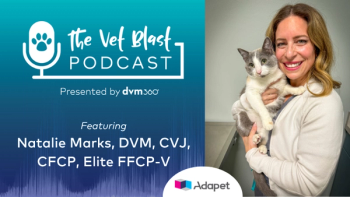
An innovative drug presents new treatment options for controlling OA pain
By Michelle Meyer, DVM, Serenity Animal Hospital and former president, American Association of Feline Practitioners
As a veterinarian, I'm fascinated and intrigued by all pets and the relationships they have with their owners - especially cats. Cats are playful, cheeky, and good at hiding, which unfortunately includes hiding pain. The ability of cats to mask their pain is an evolutionary tactic and, as veterinarians, we must recognize when pain is an adverse effect of chronic conditions such as osteoarthritis (OA) and learn how we can help control it in our feline patients.
OA is a progressive, degenerative disease of the joints, in which the normal cartilage cushion in the joints breaks down, eventually causing the bones in the joint to rub against each other, causing pain and decreased joint movement. It is one of the most common chronic diseases cats experience, affecting more than 40% of cats,1 and 90% of cats over age 12 have radiographic evidence of OA.2 What many pet owners do not realize is that pain is the most common sign of OA and, when left untreated, the implications of this pain can go beyond the physical impact.3 The pain associated with OA can also affect their emotional well-being,3 leading to a lower quality of life.4
Unfortunately, for cats experiencing OA pain, treatment options have historically been limited. Nonsteroidal anti-inflammatory drugs (NSAIDs) are sometimes used, but in the United States, they are not approved by the FDA for this. Veterinary NSAIDS can be prescribed by a veterinarian for off-label use; however, some veterinarians have concerns about their adverse effects, particularly when used in this way.
A new approach to controlling OA pain
The treatment landscape changed dramatically in January 2022, when the FDA approved a new medication from Zoetis called Solensia™ (frunevetmab injection) to control the pain of OA in cats.5 Solensia represents the first and only injectable monoclonal antibody treatment to control the pain of OA in cats.5 In field studies, this once-monthly treatment was shown to help improve cats' mobility, comfort, and overall well-being.5
Solensia targets nerve growth factor (NGF), which is a key driver of OA pain in cats. NGF is essential for the survival of sensory and sympathetic neurons during development.6 However, in an adult, NGF and its interaction with tropomyosin receptor kinase A receptors have been found to play a critical role in nociception and nervous system plasticity in pain conditions.6
In cats, Solensia functions just like naturally produced antibodies that are eliminated via normal protein degradation pathways, with minimal involvement of the liver or kidneys.7 In field studies, Solensia noticeably reduced OA pain after just a single treatment.6 In fact, 77% of cat owners saw an improvement in signs of pain when their cats were treated monthly with Solensia in a 3-month study, whereas 67% of cat owners saw an improvement in signs of their cat's pain in the placebo group.5 It was also found to be well tolerated. The most common adverse effects were vomiting and injection site pain.5
Promising early experiences
I've had the opportunity to use Solensia on older cats and even those as young as 18 months old, and the results have been quite impactful. In my practice, more than 90% of the cats I've treated with Solensia have shown improvement after the first injection. A few more cats showed improvement after the second injection, and the overall response among the cats has been positive. Pet owners have reported that their cats went from not being able to walk up a flight of stairs to navigating the staircase with ease - and jumping onto the owner's bed. They are once again socializing with their families and not hiding. Two unique case studies that speak not only to the impact of feline OA pain but also to the unique emotional bonds that owners share with their cats stand out in my mind.
Case study #1: Amy
Amy is a 16-year-old domestic medium hair cat with stage 3 kidney disease and OA, exhibiting symptoms of pain. Previous attempts to treat her pain had been unsuccessful. Amy's owner is living with an autoimmune disease that makes it difficult to get out of her bed, and one of her favorite things is sitting in her bed and watching television with Amy. Even with carpeted bedside stairs, the decreased joint movement and pain have made it difficult for Amy to get onto the bed for the past few years. As a result, Amy gradually isolated from the family and tended to lay in a corner or closet and was eventually covered in matted fur due to the inability to clean herself.
Amy received her first injection of Solensia in fall 2022, and her owner reported the results were "like night and day." Her movement was more fluid, and she was able to run around the house and visit different areas that were previously out of her reach. Amy was once again playing with her toys and jumping onto the bed to join her owner. Amy's owner noted that she "has her cat back," which is having a positive impact on her emotional health, as well.
Case study #2: Coco
Coco is a 17-year-old domestic short hair cat with diabetes mellitus and OA pain. Her owner cannot give Coco oral medications, which has limited my ability to treat her pain. I have been taking care of Coco for over 15 years, and in 2021, I observed that her left knee was thicker than her right knee. Coco's owner reported that her movement was limited, and she had trouble jumping up onto things and no longer went up and down the stairs, which he assumed was related to her advanced age. Coco was eventually diagnosed with OA, and we tried several treatments without success.
This fall, Coco received her first injection of Solensia. Shortly after the visit, I received a video from Coco's owner of her trying, and failing, to jump up on a bench in the exam room just prior to treatment, followed by another video from 1 month later, when she could. Coco is also able to walk up the stairs now, which she hasn't been able to do in 3 years. At Coco's recheck, her owner became emotional and hugged me. He finally had his cat back.
We live in a time when some of the advancements in medicine we see for diseases like cancer and genetic disorders are approaching the level of science fiction. The same is true for cats and the control of OA pain. Pet owners are demanding different approaches to how we control pain in their companions. There is an incredible amount of innovation in veterinary medicine, and it is changing the way veterinarians practice, which is exciting for pets and those who care for them.
IMPORTANT SAFETY INFORMATION: See full
The animal health information contained herein is provided for educational purposes only and is not intended to replace discussions with an animal healthcare professional. Testimonials represent individual experience only and the experiences and opinions herein may be unique to the patient and the speaker. Individual results may vary considering the unique characteristics of the patient.
1 Zoetis market research: KG MarketSense 2018 Global Veterinarian and Pet Owner.
2 Hardie EM, Roe SC, Martin FR. Radiographic evidence of degenerative joint disease in geriatric cats: 100 cases (1994-1997). J Am Vet Med Assoc. 2002;220(5):628-632. doi:10.2460/javma.2002.220.628
3 Lascelles BDX, Brown DC, Conzemius MG, Gill M, Oshinsky ML, Sharkey M. Measurement of chronic pain in companion animals: discussions from the Pain in Animals Workshop (PAW) 2017. Vet J. 2019;250:71-78. doi:10.1016/j.tvjl.2019.07.001
4 Benito J, Gruen ME, Thomson A, Simpson W, Lascelles BD. Owner-assessed indices of quality of life in cats and the relationship to the presence of degenerative joint disease. J Feline Med Surg. 2012;14(12):863-870. doi:10.1177/1098612X12453904
5 Solensia. Prescribing information. Zoetis Inc; 2021. Accessed November 17, 2022. https://www2.zoetisus.com/content/_assets/docs/solensia-pi.pdf
6 Gruen ME, Myers JAE, Lascelles BDX. Efficacy and safety of an anti-nerve growth factor antibody (frunevetmab) for the treatment of degenerative joint disease-associated chronic pain in cats: a multisite pilot field study. Front Vet Sci. 2021;8:610028. doi:10.3389/fvets.2021.610028
7 Keizer RJ, Huitema AD, Schellens JH, Beijnen JH. Clinical pharmacokinetics of therapeutic monoclonal antibodies. Clin Pharmacokinet. 2010;49(8):493-507.
Newsletter
From exam room tips to practice management insights, get trusted veterinary news delivered straight to your inbox—subscribe to dvm360.






